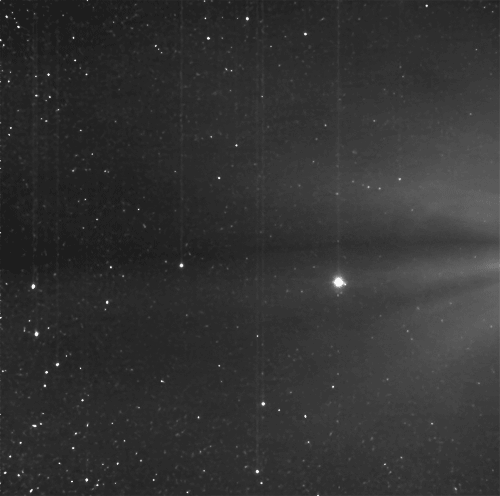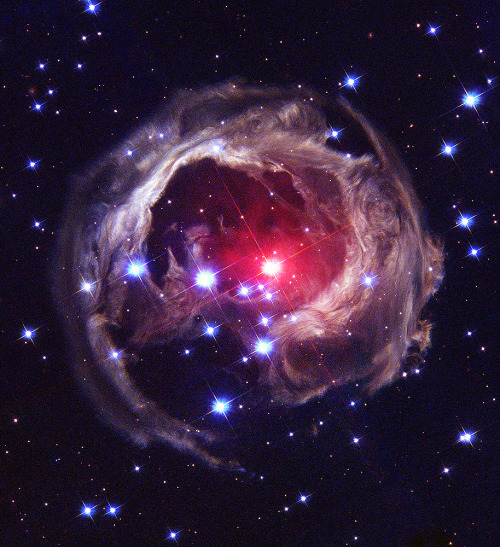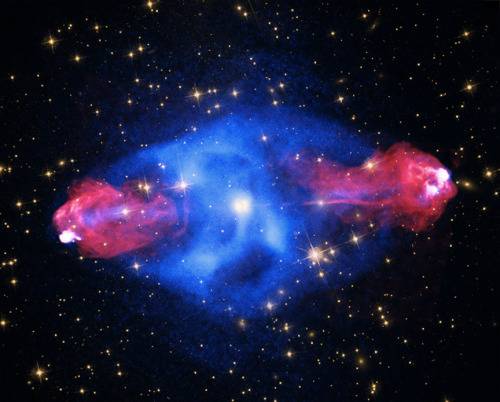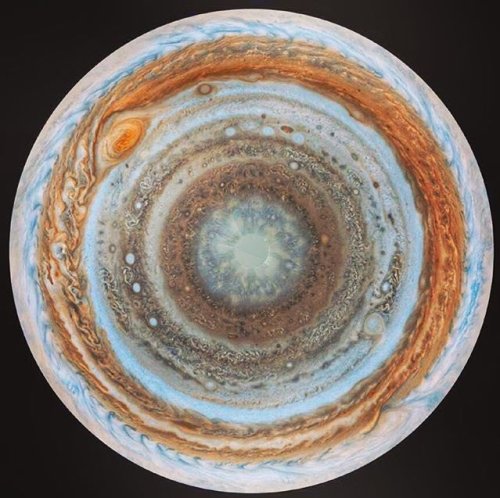Stars, Mercury, And Solar Corona, Photographed By Stereo A, January 2009.

stars, mercury, and solar corona, photographed by stereo a, january 2009.
27 frames, photographed over 36 hours, 2nd-3rd january. the sun is out of frame right.
image credit: nasa/stereo. animation: ageofdestruction.
More Posts from Xnzda and Others

Light Echoes from V838 Mon
For reasons unknown, star V838 Mon’s outer surface suddenly greatly expanded with the result that it became the brightest star in the entire Milky Way Galaxy in January 2002. Then, just as suddenly, it faded. A stellar flash like this has never been seen before.
It’s true that supernovae and novae expel matter out into space. But while the V838 Mon flash appears to expel material into space, what is seen here is actually an outwardly moving light echo of the bright flash. In a light echo, light from the flash is reflected by successively more distant rings in the ambient interstellar dust that already surrounded the star.
V838 Mon lies about 20,000 light years away toward the constellation of Monoceros the unicorn. In this Hubble Space Telescope image from February 2004, the light echo is about six light years in diameter.
Image Credit: NASA, APOD, ESA, H. E. Bond (STScI)

NASA’s planet-hunting Kepler Telescope has spotted the first roughly Earth-sized world orbiting in the “Goldilocks zone” of another star – offering perhaps the best bet so far for life elsewhere in the universe.
A year on Kepler 452b, which is about 1,400 light years from us in the constellation Cygnus, is 385 days, meaning its orbit is just a bit farther away from its star than the Earth is from the sun. That places it squarely within what planetary scientists call the habitable zone, or “Goldilocks” zone — not too cold and not too hot.
“In my mind, this is the closest planet indeed to Earth,” Jon Jenkins, Kepler data analysis lead at NASA’s Ames Research Center in Moffett Field, Calif, said at a media briefing. “The star is a little bit older and a little bit bigger and brighter, so it’s good that it’s a bit farther from its star.”
Kepler Telescope Introduces Earth To A Very Distant Cousin
Image: Artist’s concept compares Earth (left) to the new planet, called Kepler-452b, which is about 60 percent larger in diameter. Courtesy of NASA/JPL-Caltech/T. Pyle

DAT MILKY WAY

Light from Cygnus A: Celebrating astronomy in this International Year of Light, the detailed image reveals spectacular active galaxy Cygnus A in light across the electromagnetic spectrum. Incorporating X-ray data extends to either side along the same axis for nearly 300,000 light-years powered by jets of relativistic particles emanating from the galaxys central supermassive black hole. Hot spots likely mark the ends of the jets impacting surrounding cool, dense material. Confined to yellow hues, optical wavelength data of the galaxy from Hubble and the surrounding field in the Digital Sky Survey complete a remarkable multiwavelength view. via NASA
js

Cygnus entering the atmosphere, photographed by Alexander Gerst on the ISS.

Atmospheric Jellyfish are described as jellyfish-like creature seen floating in the Earth’s atmosphere. Atmospheric Jellyfish are said to look like normal jellyfish except they are floating in the sky much like a cloud and are seen mostly around military bases. Skeptics believe that the Atmospheric Jellyfish could be misidentified clouds or weather balloons however believers hold true to the idea and remember the time that NASA sent 60,000 jellyfish into space during their From Undersea to Outer Space experiment.
Cosmic rays
Cosmic rays provide one of our few direct samples of matter from outside the solar system. They are high energy particles that move through space at nearly the speed of light. Most cosmic rays are atomic nuclei stripped of their atoms with protons (hydrogen nuclei) being the most abundant type but nuclei of elements as heavy as lead have been measured. Within cosmic-rays however we also find other sub-atomic particles like neutrons electrons and neutrinos.

Since cosmic rays are charged – positively charged protons or nuclei, or negatively charged electrons – their paths through space can be deflected by magnetic fields (except for the highest energy cosmic rays). On their journey to Earth, the magnetic fields of the galaxy, the solar system, and the Earth scramble their flight paths so much that we can no longer know exactly where they came from. That means we have to determine where cosmic rays come from by indirect means.

Because cosmic rays carry electric charge, their direction changes as they travel through magnetic fields. By the time the particles reach us, their paths are completely scrambled, as shown by the blue path. We can’t trace them back to their sources. Light travels to us straight from their sources, as shown by the purple path.

One way we learn about cosmic rays is by studying their composition. What are they made of? What fraction are electrons? protons (often referred to as hydrogen nuclei)? helium nuclei? other nuclei from elements on the periodic table? Measuring the quantity of each different element is relatively easy, since the different charges of each nucleus give very different signatures. Harder to measure, but a better fingerprint, is the isotopic composition (nuclei of the same element but with different numbers of neutrons). To tell the isotopes apart involves, in effect, weighing each atomic nucleus that enters the cosmic ray detector.

All of the natural elements in the periodic table are present in cosmic rays. This includes elements lighter than iron, which are produced in stars, and heavier elements that are produced in violent conditions, such as a supernova at the end of a massive star’s life.

Detailed differences in their abundances can tell us about cosmic ray sources and their trip through the galaxy. About 90% of the cosmic ray nuclei are hydrogen (protons), about 9% are helium (alpha particles), and all of the rest of the elements make up only 1%. Even in this one percent there are very rare elements and isotopes. Elements heavier than iron are significantly more rare in the cosmic-ray flux but measuring them yields critical information to understand the source material and acceleration of cosmic rays.

Even if we can’t trace cosmic rays directly to a source, they can still tell us about cosmic objects. Most galactic cosmic rays are probably accelerated in the blast waves of supernova remnants. The remnants of the explosions – expanding clouds of gas and magnetic field – can last for thousands of years, and this is where cosmic rays are accelerated. Bouncing back and forth in the magnetic field of the remnant randomly lets some of the particles gain energy, and become cosmic rays. Eventually they build up enough speed that the remnant can no longer contain them, and they escape into the galaxy.

Cosmic rays accelerated in supernova remnants can only reach a certain maximum energy, which depends on the size of the acceleration region and the magnetic field strength. However, cosmic rays have been observed at much higher energies than supernova remnants can generate, and where these ultra-high-energies come from is an open big question in astronomy. Perhaps they come from outside the galaxy, from active galactic nuclei, quasars or gamma ray bursts.

Or perhaps they’re the signature of some exotic new physics: superstrings, exotic dark matter, strongly-interacting neutrinos, or topological defects in the very structure of the universe. Questions like these tie cosmic-ray astrophysics to basic particle physics and the fundamental nature of the universe. (source)
-
 imdarklizard liked this · 1 month ago
imdarklizard liked this · 1 month ago -
 i-am-mr-k liked this · 1 month ago
i-am-mr-k liked this · 1 month ago -
 vladimirpootietang liked this · 1 month ago
vladimirpootietang liked this · 1 month ago -
 xdxtt liked this · 1 month ago
xdxtt liked this · 1 month ago -
 stargirlisle reblogged this · 1 month ago
stargirlisle reblogged this · 1 month ago -
 jeslilas reblogged this · 1 month ago
jeslilas reblogged this · 1 month ago -
 craziestgrlevr reblogged this · 1 month ago
craziestgrlevr reblogged this · 1 month ago -
 simurguvercinka liked this · 2 months ago
simurguvercinka liked this · 2 months ago -
 opalflowersforever reblogged this · 2 months ago
opalflowersforever reblogged this · 2 months ago -
 tadeuszip reblogged this · 3 months ago
tadeuszip reblogged this · 3 months ago -
 joywavve reblogged this · 3 months ago
joywavve reblogged this · 3 months ago -
 joywavve liked this · 3 months ago
joywavve liked this · 3 months ago -
 inkprilled liked this · 3 months ago
inkprilled liked this · 3 months ago -
 dirkdecker liked this · 3 months ago
dirkdecker liked this · 3 months ago -
 lux-tenebrae reblogged this · 3 months ago
lux-tenebrae reblogged this · 3 months ago -
 katsmith87 reblogged this · 3 months ago
katsmith87 reblogged this · 3 months ago -
 tmbyykk reblogged this · 3 months ago
tmbyykk reblogged this · 3 months ago -
 justbarrowsing reblogged this · 3 months ago
justbarrowsing reblogged this · 3 months ago -
 justbarrowsing liked this · 3 months ago
justbarrowsing liked this · 3 months ago -
 quiietballerina reblogged this · 3 months ago
quiietballerina reblogged this · 3 months ago -
 funeral-de-lacrimae liked this · 3 months ago
funeral-de-lacrimae liked this · 3 months ago -
 analogylarasa liked this · 3 months ago
analogylarasa liked this · 3 months ago -
 takeuchiitsuka liked this · 4 months ago
takeuchiitsuka liked this · 4 months ago -
 etoticdraw liked this · 4 months ago
etoticdraw liked this · 4 months ago -
 maromisdream reblogged this · 4 months ago
maromisdream reblogged this · 4 months ago -
 s-h-y-y-a-n-n-e liked this · 4 months ago
s-h-y-y-a-n-n-e liked this · 4 months ago -
 pearl-and-the-violet-rose reblogged this · 4 months ago
pearl-and-the-violet-rose reblogged this · 4 months ago -
 whiteground liked this · 5 months ago
whiteground liked this · 5 months ago -
 aijolomulupkosu reblogged this · 5 months ago
aijolomulupkosu reblogged this · 5 months ago -
 nat-a-castiyo liked this · 5 months ago
nat-a-castiyo liked this · 5 months ago -
 automaticdetectivedetective liked this · 5 months ago
automaticdetectivedetective liked this · 5 months ago -
 goldlionaz reblogged this · 5 months ago
goldlionaz reblogged this · 5 months ago -
 stawr liked this · 5 months ago
stawr liked this · 5 months ago -
 luciyaya reblogged this · 5 months ago
luciyaya reblogged this · 5 months ago -
 skyseastarr liked this · 5 months ago
skyseastarr liked this · 5 months ago -
 aiyanna-a reblogged this · 5 months ago
aiyanna-a reblogged this · 5 months ago -
 284-psilocybin252 liked this · 5 months ago
284-psilocybin252 liked this · 5 months ago -
 aelffy reblogged this · 5 months ago
aelffy reblogged this · 5 months ago -
 disscog liked this · 5 months ago
disscog liked this · 5 months ago -
 someforgottonstreet liked this · 5 months ago
someforgottonstreet liked this · 5 months ago -
 lunarmountains reblogged this · 5 months ago
lunarmountains reblogged this · 5 months ago -
 infinitefern reblogged this · 5 months ago
infinitefern reblogged this · 5 months ago -
 juliansummerhayes reblogged this · 5 months ago
juliansummerhayes reblogged this · 5 months ago -
 juliansummerhayes liked this · 5 months ago
juliansummerhayes liked this · 5 months ago -
 lionsweet liked this · 5 months ago
lionsweet liked this · 5 months ago -
 eduardorivas reblogged this · 5 months ago
eduardorivas reblogged this · 5 months ago



